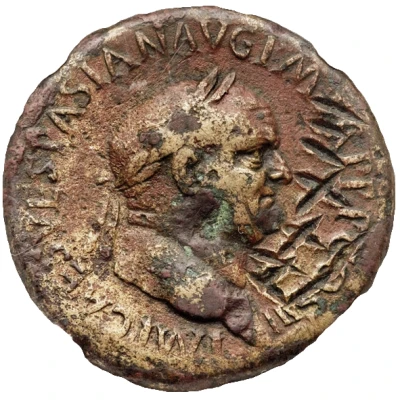


© Heritage Auctions
83 Nummi Countermark; Sestertius of Vespasian,
| Bronze | 25.20 g | 33 mm |
| Issuer | Ostrogothic Kingdom |
|---|---|
| Type | Standard circulation coin |
| Years | 501-553 |
| Value | 83 Nummi = ⅙ Siliqua = 1⁄48 Tremissis |
| Currency | Tremissis (490-553) |
| Composition | Bronze |
| Weight | 25.20 g |
| Diameter | 33 mm |
| Shape | Round (irregular) |
| Technique | Hammered, Countermarked |
| Demonetized | Yes |
| Updated | 2024-10-10 |
| Numista | N#166595 |
|---|---|
| Rarity index | 95% |
Reverse
Bounded, standing person and captive around palm tree, all surrounded by legend.
Script: Latin
Lettering:
IVDAEA CAPTA
S C
Translation:
Judaea Capta / Senatus Consulto
Judea Conquered / By Decree of the Senate
Edge
Plain
Comment
These countermarked coins came in two denominations: 42 Nummi and 83 Nummi. While their values are quite odd in comparison to other Ostrogothic coins, these coins were not intended to be used as general nummus pieces, but rather fractions of the Siliqua (1/12 and 1/6 of one, respectively). While these denominations in nummi are not perfectly divisible by the equivalent values in siliquae, these values are as close to the proper divisions as possible.The host coin for this piece is a Rome mint, 1 Sestertius struck under Vespasianus (69-79), and these were said to be countermarked in the early- to mid-6th century. With the Ostrogothic Kingdom falling in 553, that is the latest possible end-date.
Around 150 countermarked coins are known, with the vast majority being found in Italy. Because the host coins were minted hundreds of years before the countermarks were applied, it is suggested that a hoard of these host coins were found, which prompted some local mint in Ostrogothic Italy to start countermarking them.
Interesting fact
One interesting fact about this coin is that it was issued during the reign of Vespasian, who was the Roman Emperor from 69 to 79 AD. The coin was minted in the Ostrogothic Kingdom, which was a Germanic kingdom that existed in Italy during the 6th century. The use of a Roman Emperor's image on the coin suggests that the Ostrogothic Kingdom was still under Roman influence at the time. Additionally, the fact that it was made of bronze and weighs 25.20 grams suggests that it was a widely circulating coin used for everyday transactions.



